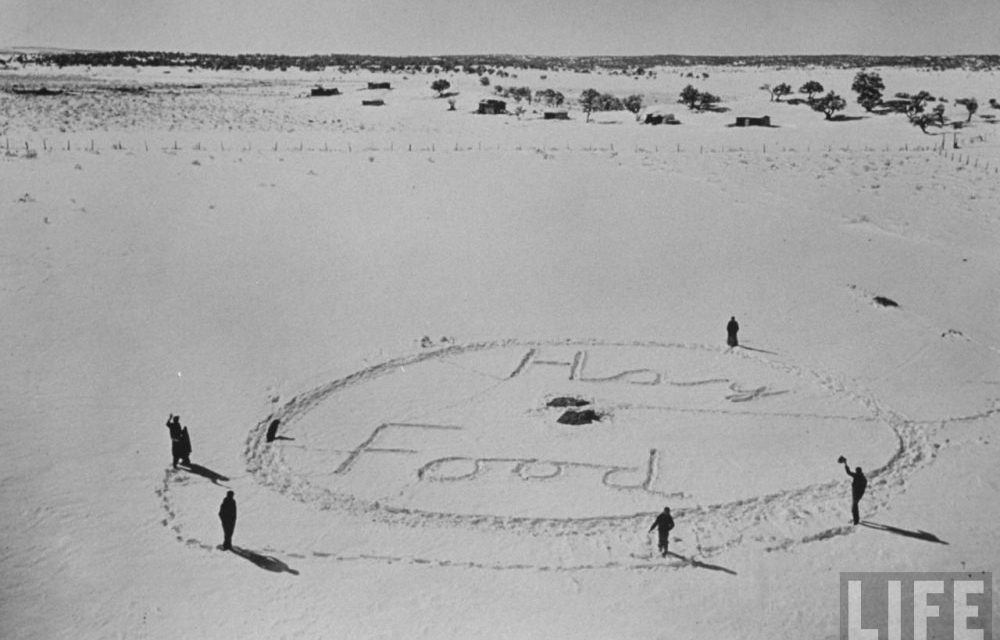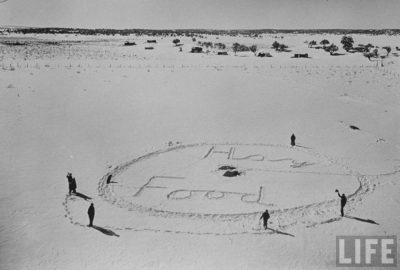
50 Years Ago: Planeloads of food, gifts arrive for stranded Diné

Navajo shepherds hard hit by snow storm stamped out a sign requesting food & hay in 1967. (Ralph Crane, Life magazine.)
As the snowstorms of December 1967 became history, the planes started coming almost on an hourly basis to the Window Rock airstrip bringing everything from food to dolls for the Navajo people.

Navajo shepherds hard hit by snow storm stamped out a sign requesting food & hay in 1967. (Ralph Crane, Life magazine.)
As 1968 began, reports came in on a daily basis of people off the reservation bringing help to reservation residents.
Job Corpsmen in Winslow and Mexican Springs gave up part of their Christmas vacation to help clear roads and prepare food for shipment to stranded families.
The Winslow group alone prepared 4,000 packages of food consisting of some 162,000 pounds of food products. Officials said that some citizens in Winslow even volunteered their services to help prepare the food packages.
Russell Quinn, president of Flight Test Research out of Long Beach, California, arrived on Jan. 2 on one of his planes with thousands of pounds of food collected in California.
Later that day, Danny Davey, out of Costa Mesa, California, flew in along with a Marine Corps unit from El Toro, California, loaded with toys for reservation children.
“Ten thousand children in California gave up a toy for the Navajos,” Davey said.
Davey, an employee of the United Parcel Service, said he collected hundreds of dolls to be given to Navajo girls. Some 1,500 girls in California either repaired or brought a doll to be sent to the reservation.
In other things being reported by the Times in the first week of 1968, the paper’s editor, Dick Hardwick, printed this joke in his column “Smoke Signals from Hardwick’s Hogan”:
“A Navajo grandmother was telling her young granddaughter about the Long Walk and the privations the people suffered on the journey.
“The little girl thought about it for a moment and then asked, ‘Grandmother, why didn’t they take a bus?’”
The letters section that week had several in connection with a letter the Times had printed a couple of weeks earlier from Leta Myers, an Omaha tribal member, who asked why Navajo leaders allowed its members to use peyote “when it keeps people doped up half the time.”
A 14-year-old female student from Shiprock who did not allow her name to be used wrote an angry letter asking what were Myers’ reasons for saying this.
“She probably doesn’t now how many people are engaged in the Native American Church,” she said. “She might think we are using it for kicks.
“She calls it evil. I wonder what it did to her to make her say such dirty things about our religion,” the Shiprock student said. “I might not be old enough to understand it, but I have my own belief in it too and will have faith in it as long as I live.”
By the way, the first issue of 1968 was only 16 pages, one of the lowest numbers in years. Hardwick said that because so much of the Navajo population was still stranded at homes, advertisement hit a low because businesses didn’t see any sense in advertising their business if no one could get to them.
He also said the paper had cut its circulation almost in half since it was still only going to the major communities because travel on secondary roads was still impossible.
And in some of these communities the stores the paper usually dropped off papers at were closed so a decision was made to drop off any leftover papers at chapters and let the people read them for free.
Navajo Tribal Chairman Raymond Nakai said there were discussions about whether to postpone the winter meeting of the Navajo Tribal Council, which was scheduled to begin the next Tuesday.
Nakai said he was wondering how many of the Council would be able to make it to window Rock if there was another snowstorm.
He said it didn’t make a lot of sense to make delegates travel all the way to Window Rock if not enough would be able to make it to get a quorum.
After discussing it with others in the Council, he decided to go ahead and hold the meeting although he reserved the right the day before to call it off if the weather turned threatening.
To read the full article, pick up your copy of the Navajo Times at your nearest newsstand Thursday mornings!
Are you a digital subscriber? Read the most recent three weeks of stories by logging in to your online account.








 Highway 264,
Highway 264, I-40, WB @ Winslow
I-40, WB @ Winslow